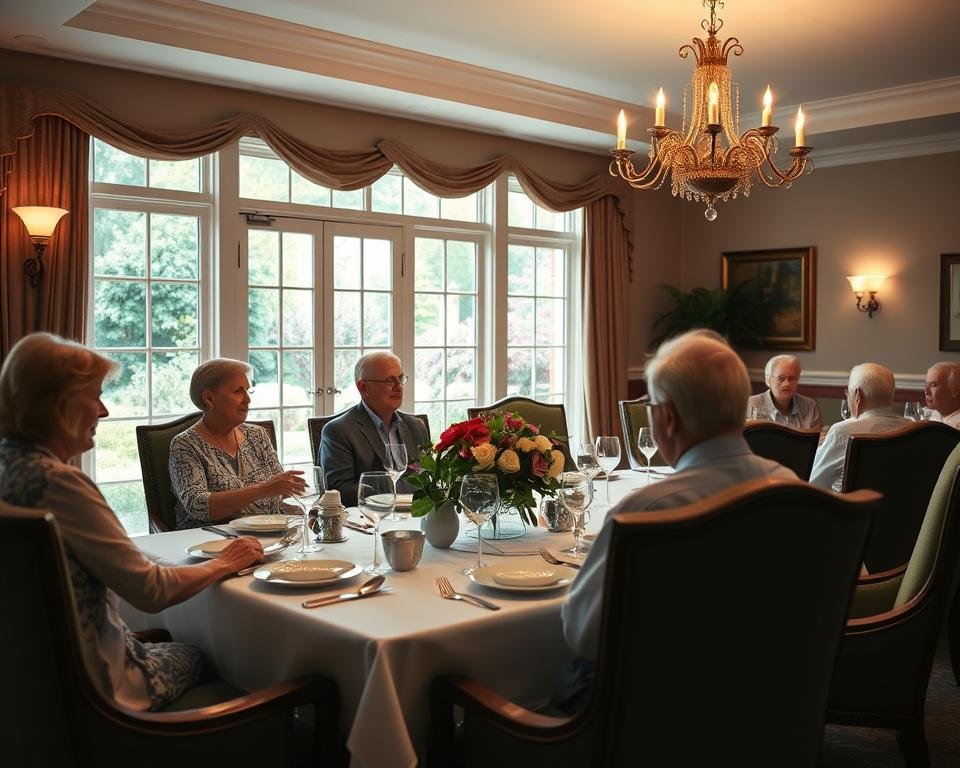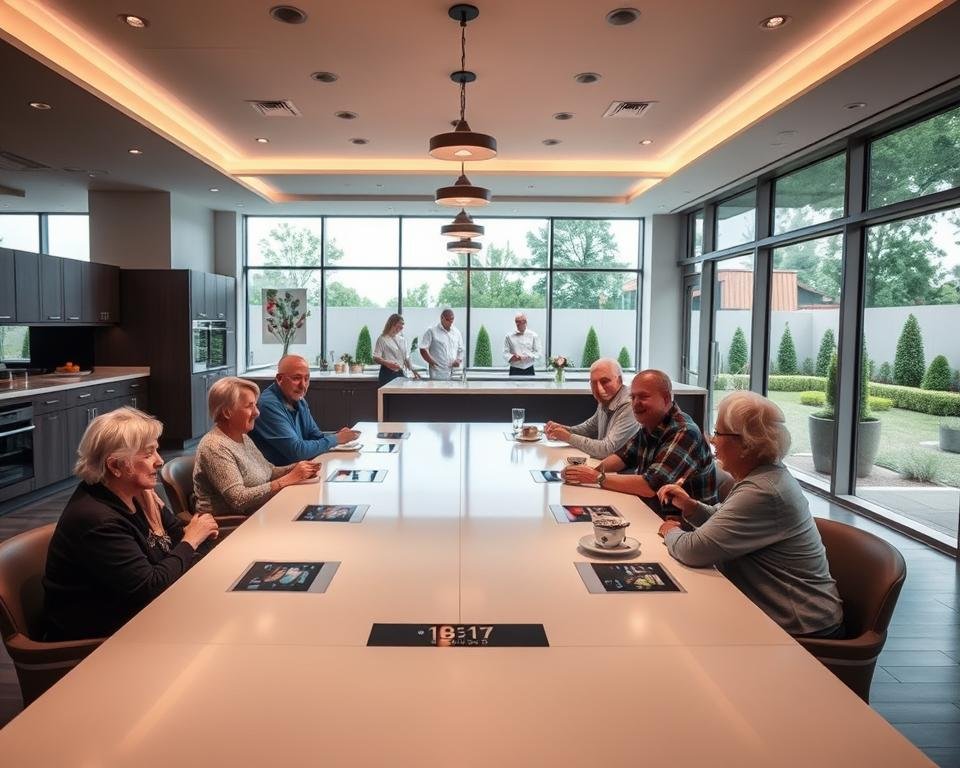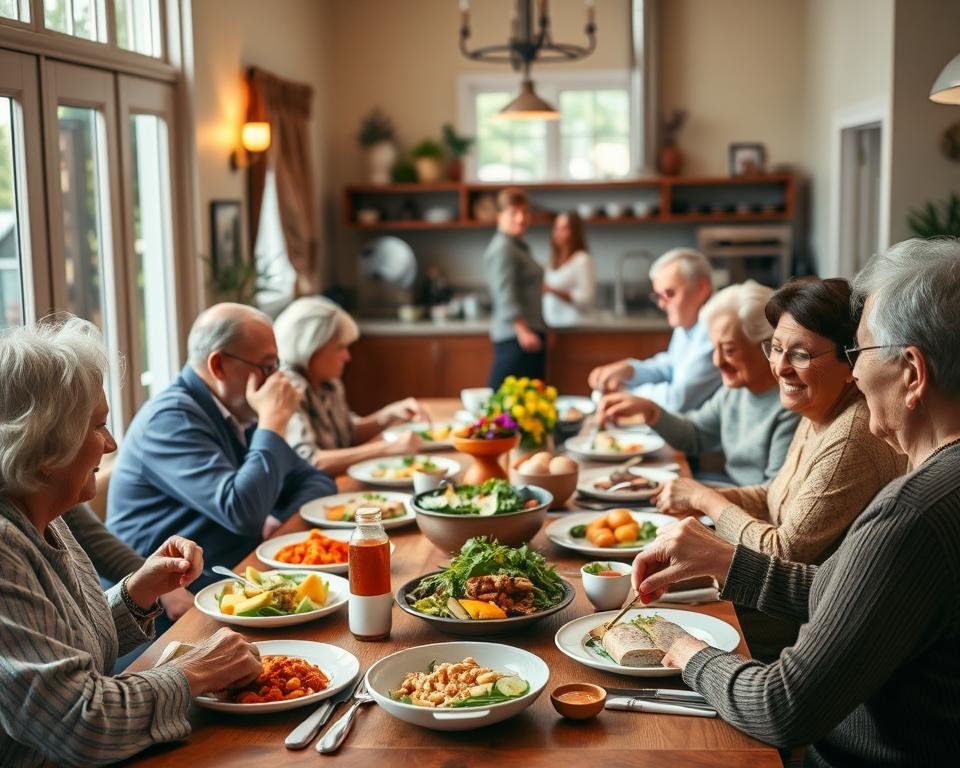Did you know 78% of seniors say meal quality directly impacts their choice of community? Modern retirement isn’t just about convenience—it’s about savoring flavorful, nutritious dishes that spark joy. Today’s senior-focused communities have transformed their culinary programs, blending nutrition with creativity to create memorable experiences.
Gone are the days of bland, repetitive menus. Instead, you’ll find chef-inspired meals crafted with seasonal, locally sourced produce. Many communities now offer restaurant-style settings where you can enjoy made-to-order entrees alongside friends. This shift isn’t just about taste—it’s about fostering connection and celebrating individuality through food.
Whether you prefer gluten-free, plant-based, or classic comfort foods, personalized choices are now standard. Independent living arrangements often include flexible meal plans that adapt to your preferences and dietary needs. Imagine selecting fresh salmon with dill sauce or a hearty vegetable lasagna—all prepared by skilled culinary teams.
Key Takeaways
- Modern communities prioritize fresh, high-quality ingredients to elevate every meal
- Customizable menus cater to diverse dietary preferences and health requirements
- Restaurant-style dining fosters social connections and a sense of occasion
- Seasonal rotations keep menus exciting and aligned with local harvests
- Nutritional expertise ensures meals support overall wellness without sacrificing flavor
Introduction: The Importance of a Quality Dining Experience
What transforms a simple meal into a highlight of the day? For many older adults, it’s the combination of vibrant flavors, welcoming spaces, and thoughtful preparation. Exceptional culinary programs now play a starring role in modern retirement communities, shaping daily routines and fostering meaningful connections.
Setting the Stage for Memorable Meals
Imagine walking into a sunlit dining area where seasonal bouquets adorn tables and chefs greet you by name. This attention to detail creates an atmosphere where every bite feels special. Communities prioritizing nutritionally balanced menus see residents enjoying 23% more social interactions during meals, according to recent studies.
Enhancing Satisfaction Through Thoughtful Design
Chefs now craft dishes that appeal to both the eye and palate. Bright vegetable medleys, artfully plated proteins, and colorful desserts turn meals into multisensory experiences. One community director notes: “When food looks inviting, it sparks conversation and appetite – especially for those with changing taste preferences.”
Forward-thinking locations integrate technology like digital menu boards and allergy-aware ordering systems. These innovations pair perfectly with farm-to-table initiatives that bring local strawberries or heirloom tomatoes straight to your plate. The result? Meals become moments of discovery rather than routine.
Embracing Dining Options in Independent Living Homes
Modern retirement communities are redefining mealtime through creative approaches that honor individual tastes. Chefs now craft menus reflecting seasonal harvests and regional flavors, with many partnering directly with nearby farms. This ensures every dish bursts with freshness while supporting local growers.

Specialized culinary programs adapt to your unique needs, whether managing dietary restrictions or exploring new cuisines. One resident shares: “Having gluten-free pancakes and vegan chili on the same menu makes gatherings with friends truly inclusive.” From classic meatloaf to turmeric-infused cauliflower steaks, variety keeps meals exciting.
Tech enhancements streamline the experience without sacrificing personal touch. Digital displays show real-time ingredient sources, while app-based ordering lets you customize dishes days in advance. These tools empower you to make informed choices while reducing wait times.
Communities also address common assisted living myths by offering flexible eating schedules. Whether you crave an early breakfast or late-night snack, kitchens accommodate your rhythm. This freedom transforms nourishment from obligation to daily pleasure.
Ultimately, these innovations create spaces where breaking bread becomes a celebration of autonomy. When meals align with your lifestyle and values, every bite reinforces your sense of belonging and joy.
Innovative Trends Shaping Senior Living Dining
Imagine savoring a meal where every ingredient tells a story of wellness and connection. Retirement communities now blend culinary artistry with science, creating menus that nourish both body and spirit. This evolution goes beyond recipes—it’s about building food cultures that celebrate vitality.
Healthier Food Options and Nutritional Education
Chefs now craft dishes bursting with superfoods like quinoa and antioxidant-rich berries. Over 60% of communities offer cooking classes where you can learn to make heart-healthy versions of your favorite meals. One resident shares: “Discovering how spices replace salt changed how I enjoy food—it’s like unlocking flavor secrets!”
Nutritionists regularly host workshops explaining how specific foods support bone health or cognitive function. These sessions often feature tastings, letting you experience the benefits of nutrient-dense ingredients firsthand.
Farm-to-Table and Locally Sourced Ingredients
Many locations partner with nearby farms to serve sun-ripened tomatoes and crisp greens harvested that morning. Seasonal menus adapt weekly, ensuring peak freshness. Some communities even maintain resident-tended herb gardens—a fragrant blend of practicality and pride.
This approach reduces food miles while supporting regional agriculture. As one chef notes: “When we know the farmer who grew these carrots, every slice feels intentional.” From heirloom apples to pasture-raised eggs, locally sourced items transform ordinary meals into conversations with your environment.
Personalized Menus and Customizable Dining Experiences
Personalized dining isn’t a luxury—it’s your new normal. Modern senior living communities craft menus that evolve with your preferences, turning every meal into a reflection of your tastes and health requirements. This approach ensures you never have to compromise flavor for nourishment.
Catering to Dietary Restrictions and Preferences
Chefs now design meals around your unique needs. Gluten-free waffles, low-sodium soups, and diabetic-friendly desserts are standard offerings. One resident remarks: “Knowing my lentil curry uses no added salt lets me enjoy meals without worry.” Nutritional teams collaborate with you to create balanced plates that support specific health goals.
Empowering Residents with Menu Choices
You shape your dining journey through daily selections. Digital platforms let you preview menus days in advance, swapping sides or requesting protein alternatives. Heart-healthy salmon or plant-based chili? The choice remains yours. Communities report a 42% increase in satisfaction when residents actively participate in meal planning.
This flexibility extends beyond food preferences. When exploring meal plan possibilities, you’ll find options aligning with cultural traditions or family recipes. Whether it’s recreating Grandma’s chicken soup or trying tahini-roasted veggies, your story flavors every dish.
Ultimately, personalization transforms meals from routine to revelation. When kitchens honor your individuality, every bite becomes a celebration of who you are—and who you’re becoming.
Flexible Meal Plans and All-Day Dining Options
Your schedule shouldn’t dictate when you enjoy great food. Modern communities recognize that hunger doesn’t follow a clock, offering meal plans that bend to your rhythm rather than rigid timetables. This approach respects your lifestyle while ensuring nourishment aligns with your needs.
Embracing Non-Traditional Dining Hours
Early birds and night owls alike find their needs met through extended service hours. Many locations keep kitchens open from 7 AM to 8 PM, with grab-and-go stations available around the clock. One resident shares: “I take medication that affects my appetite—having soup at 10 PM makes life easier.”
Communities now provide lighter bites between main meals, like fresh fruit smoothies or avocado toast. These options help maintain energy levels without overwhelming portion sizes. A recent survey shows 68% of residents prefer this grazing-style approach to traditional three-meal structures.
Late-Night Dining and Brunch Options
Midnight grilled cheese deliveries and Sunday champagne brunches are becoming signature offerings. Chefs design late-night menus with digestion in mind—think turkey wraps or yogurt parfaits rather than heavy dishes. Weekend brunches often feature build-your-own omelet bars and live music, turning meals into social events.
This flexibility does more than satisfy cravings. It empowers you to host grandchildren for pancakes at noon or enjoy quiet coffee dates after sunset. When food adapts to your life—not the other way around—every day feels deliciously yours.
Integrating Technology into the Dining Experience
The future of senior dining is here, powered by innovative tech solutions. Communities now blend cutting-edge tools with culinary expertise to create safer, smarter mealtimes. These advancements streamline operations while preserving the warmth of shared meals.

Electronic Menus and Touchless Payment Systems
Tablets mounted in common areas let you browse rotating specials or pre-order tomorrow’s breakfast. Digital displays highlight nutritional info and allergy alerts with a tap. Contactless payments through wristbands or resident cards eliminate fumbling for wallets—just scan and enjoy.
One diner shares: “I love ordering roasted turkey via the app while playing bridge—it’s ready when I am!” Systems even remember your favorite substitutions, like swapping mashed potatoes for quinoa salad.
Smart Kitchens and Data-Driven Menu Enhancements
Behind the scenes, chefs analyze real-time data to spot trends. If 40% of residents request extra ginger in stir-fry dishes, next week’s menu might feature ginger-glazed carrots. Sensors in ovens ensure perfect doneness, while robotic servers deliver trays to tables, freeing staff for conversations.
These innovations make meals both precise and personal. As one culinary director notes: “Technology handles repetition so we can focus on creativity.” From tracking sodium intake to optimizing cooking temps, every byte serves your satisfaction.
Restaurant-Style and Assisted Living Dining Experiences
Picture linen-clad tables where laughter mingles with the clink of fine china—this is today’s culinary revolution for older adults. Spaces once designed for basic nourishment now spark joy through thoughtful details like fresh floral arrangements and ambient lighting. These environments blend the comfort of home with the sophistication of boutique eateries.
Creating a Social and Inviting Ambience
Professionally trained staff greet you by name while presenting daily specials on polished silver trays. Communities report 31% longer meal times when residents linger over coffee and dessert with neighbors. One hostess shares: “We set tables with cloth napkins because details matter—it shows respect for their life experiences.”
Reservation systems prevent overcrowding, allowing everyone to enjoy unhurried conversations. A Midwest community reduced peak-hour congestion by 40% using timed seating slots. This balance of structure and flexibility lets you choose between lively group tables or intimate two-tops.
Addressing In-Room and Anytime Dining Needs
For days when you crave solitude, meals arrive in your suite on proper dishware—no plastic trays. Chefs adapt menus for in-room service, ensuring presentation remains appealing even off-site. A resident notes: “Having shrimp scampi delivered when I’m under the weather makes me feel truly cared for.”
Kitchens stay open beyond traditional hours to accommodate early risers or night owls. Grab-and-go stations offer artisanal sandwiches and fresh salads around the clock. This flexibility ensures your routine—not institutional schedules—shapes your day.
Cultural Influences and Global Culinary Inspirations
What if your next meal could transport you to Tokyo or Tuscany? Retirement communities now celebrate world flavors through creative programming that turns dinner into an adventure. These initiatives honor diverse backgrounds while introducing exciting new tastes.

Exploring International Menu Offerings
Chefs craft rotating menus featuring authentic dishes from across continents. One resident raves: “Our Moroccan tagine night let me revisit my Peace Corps days—the saffron aroma was spot-on!” From Vietnamese pho bars to Greek mezze platters, these meals become edible passports.
Nutrition teams adapt traditional recipes to meet health needs without losing cultural essence. Low-sodium miso soup and whole-grain naan bread show how global cuisine can align with wellness goals. Monthly theme nights often pair meals with music or decor for full immersion.
Pop-Up Dining and Unique Community Events
Guest chefs transform dining rooms into temporary hotspots, offering limited-time tasting menus. A recent “Parisian Bistro Night” featured duck confit and crème brûlée prepared by a visiting French culinary team. These events create buzz—many residents invite family members to share the experience.
Cultural festivals blend food with storytelling, like Diwali celebrations with homemade sweets or Oktoberfest with pretzel-making demos. A community director notes: “When grandchildren help roll sushi during Japanese week, three generations connect through shared joy.” This approach keeps menus fresh while building bridges between cultures.
By embracing global inspirations, communities reduce the risk of culinary boredom and spark daily discovery. Every bite becomes an opportunity to explore, remember, and connect.
Benefits of Exceptional Dining in Senior Living Communities
Exceptional culinary programs have become game-changers for modern retirement communities. These initiatives do more than fill plates—they shape perceptions, build reputations, and create vibrant social ecosystems where residents thrive.
Attracting New Residents with Outstanding Meals
Families touring communities often request kitchen tours first. 83% of prospective residents say meal quality directly impacts their decision, according to recent industry surveys. A family member shares: “Seeing the chef’s garden and tasting the salmon convinced us this was home for Mom.”
Communities with innovative food programs report:
- 28% faster occupancy rates compared to standard facilities
- 19% higher resident retention year-over-year
- 34% reduction in marketing costs through word-of-mouth referrals
Improving Overall Quality of Life Through Food
Nutrient-rich meals combat common age-related conditions like osteoporosis and hypertension. But the magic happens beyond nutrition—shared meals become daily celebrations that spark laughter and new friendships. One resident notes: “Our lunch table solved yesterday’s crossword puzzle together!”
Flexible service hours and diverse menus ensure everyone finds joy in their meals. Whether you prefer sunrise oatmeal or midnight tomato soup, kitchens adapt to your rhythm. This personalized approach reduces malnutrition risks by 41% while fostering deep community connections.
By prioritizing culinary excellence, these spaces transform nourishment into nourishment and connection. The result? A thriving environment where every bite supports both physical health and emotional fulfillment.
Conclusion
The evolution of culinary programs has redefined what mealtime means for older adults. From chef-curated menus to tech-enhanced convenience, today’s senior living communities blend nutrition with creativity. These innovations prove meals can be both nourishing and joyful.
Personalized choices empower you to savor dishes that align with your tastes and health goals. Cultural events and flexible schedules turn shared meals into opportunities for connection. When kitchens prioritize your preferences, every bite becomes a celebration of individuality.
Imagine how these strategies could enrich your loved one’s daily routine. Could farm-fresh ingredients or themed dinners spark new conversations? Might extended hours better suit their rhythm?
Exceptional culinary experiences do more than feed the body—they nurture belonging. Ready to explore how these trends can transform your community? Start by discussing possibilities with local experts or reviewing success stories from leading facilities. After all, great food deserves great company.
